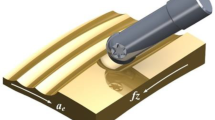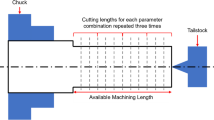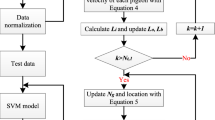Abstract
There is an urgent demand for free-form products in industry at the present time because of their superior appearance and the wide variety of functions they perform. Five-axis high-speed CNC machining technology has developed to satisfy this demand, but further improvement in surface quality metric inspection technology is the big challenge it now faces. In this study, the effects of jerk on the performance of five-axis synchronous high-speed CNC ball nose end mills on a freeform turbine mold were investigated. The relationships of characteristics of the images of 14 jerk-cluster finished workpieces with different jerk setting values were established, allowing surface texture features to be analyzed and surface roughness predicted. In addition, machine learning methods were integrated with the surface feature analysis to construct a virtual machining module that acts as a performance prediction system, merging the virtual machine tool functions, surface texture processor, and AI roughness prediction processor. Using the geometric information of the workpiece, cutting parameters and machine tool parameters as inputs, product performance metrics combining surface roughness and machining time can be predicted as outputs of the system. The integrated system provides users with a way to evaluate manufacturing performance before performing actual operations and to reduce test time for cutting parameter development. The model is suitable for complex surface finishes as well as for the production of small batches with high parametric variance. In addition, the partial set of image processing and roughness prediction modules can be used alone as an effective intelligent surface quality inspection system.














Similar content being viewed by others
Data availability
All data sets generated in this study are available from the corresponding author upon reasonable request.
References
Jia ZY, Ma JW, Song DN, Wang FJ, Liu W (2018) A review of contouring-error reduction method in multi-axis CNC machining. Int J Mach Tools Manuf 125:34–54. https://doi.org/10.1016/j.ijmachtools.2017.10.008
Lai ZH, Tao W, Leu MC, Yin Z (2020) Smart augmented reality instructional system for mechanical assembly towards worker-centered intelligent manufacturing. J Manuf Syst 55:69–81. https://doi.org/10.1016/j.jmsy.2020.02.010
Ansoategui I, Campa FJ, López C, Díez M (2017) Influence of the machine tool compliance on the dynamic performance of the servo drives. Int J Adv Manuf Technol 90:2849–2861. https://doi.org/10.1007/s00170-016-9616-y
Duong TQ, Rodriguez-Ayerbe P, Lavernhe S, Tournier C, Dumur D (2018) Contour error pre-compensation for five-axis high speed machining: offline gain adjustment approach. Int J Adv Manuf Technol 100:3113–3125. https://doi.org/10.1007/s00170-018-2859-z
Weng WH, Kuo CFJ (2019) Jerk decision for free-form surface effects in multi-axis synchronization manufacturing. Int J Adv Manuf Technol 105:799–812. https://doi.org/10.1007/s00170-019-04164-5
Tsai MS, Huang YC (2016) A novel integrated dynamic acceleration/deceleration interpolation algorithm for a CNC controller. Int J Adv Manuf Technol 87:279–292. https://doi.org/10.1007/s00170-016-8444-4
Chu CH, Chen HY, Chang CH (2020) Continuity-preserving tool path generation for minimizing machining errors in five-axis CNC flank milling of ruled surfaces. J Manuf Syst 55:171–178. https://doi.org/10.1016/j.jmsy.2020.03.004
Castagnetti C, Duc E, Ray P (2008) The domain of admissible orientation concept: a new method for five-axis tool path optimization. Comput Aided Des 40:938–950. https://doi.org/10.1016/j.cad.2008.07.002
Han J, Jiang Y, Tian X, Chen F, Lu C, Xia L (2018) A local smoothing interpolation method for short line segments to realize continuous motion of tool axis acceleration. Int J Adv Manuf Technol 95:1729–1742. https://doi.org/10.1007/s00170-017-1264-3
Erkorkmaz K, Altintas Y (2001) High speed CNC system design. Part I: jerk limited trajectory generation and quintic spline interpolation. Int J Mach Tools Manuf 41:1323–1345. https://doi.org/10.1016/S0890-6955(01)00002-5
Beudaert X, Pechard PY, Tournier C (2011) 5-Axis tool path smoothing based on drive constraints. Int J Mach Tools Manuf 51:958–965. https://doi.org/10.1016/j.ijmachtools.2011.08.014
Barre PJ, Bearee R, Borne P, Dumetz E (2005) Influence of a jerk controlled movement law on the vibratory behaviour of high-dynamics systems. J Intell Manuf 42:275–293. https://doi.org/10.1007/s10846-004-4002-7
Zhang Y, Ye P, Wu J, Zhang H (2018) An optimal curvature-smooth transition algorithm with axis jerk limitations along linear segments. Int J Adv Manuf Technol 95:875–888. https://doi.org/10.1007/s00170-017-1274-1
Tulsyan S, Altintas Y (2015) Local toolpath smoothing for five-axis machine tools. Int J Mach Tools Manuf 96:15–26. https://doi.org/10.1016/j.ijmachtools.2015.04.014
Sato Y, Nakanishi T, Sato R, Shirase K, Oda M, Nakayama N (2016) Study on the evaluation method for finished surface based on human visual characteristic. In 2016 International Symposium on Flexible Automation (ISFA) 428-431. https://doi.org/10.1109/ISFA.2016.7790201
Jeyapoovan T, Murugan M (2013) Surface roughness classification using image processing. Meas 46:2065–2072. https://doi.org/10.1016/j.measurement.2013.03.014
Manish R, Venkatesh A, Ashok SD (2018) Machine vision based image processing techniques for surface finish and defect inspection in a grinding process. Mater Today Proc 5:12792–12802. https://doi.org/10.1016/j.matpr.2018.02.263
Lu C (2008) Study on prediction of surface quality in machining process. J Mater Process Technol 205:439–450. https://doi.org/10.1016/j.jmatprotec.2007.11.270
Wang J, Fu P, Gao RX (2019) Machine vision intelligence for product defect inspection based on deep learning and Hough transform. J Manuf Syst 51:52–60. https://doi.org/10.1016/j.jmsy.2019.03.002
Martínez SS, Vázquez CO, García JG, Ortega JG (2017) Quality inspection of machined metal parts using an image fusion technique. Meas 111:374–383. https://doi.org/10.1016/j.measurement.2017.08.002
Cuka B, Cho M, Kim DW (2018) Vision-based surface roughness evaluation system for end milling. Int J Comput Integr Manuf 2018:727–738. https://doi.org/10.1080/0951192X.2017.1407451
Joshi KN, Patil BT (2018) A review of machine vision based evaluation of surface roughness using texture analysis techniques. Ind Eng J 11. https://doi.org/10.26488/IEJ.11.11.1150
Wang J, Ma Y, Zhang L, Gao RX, Wu D (2018) Deep learning for smart manufacturing: methods and applications. J Manuf Syst 48:144–156. https://doi.org/10.1016/j.jmsy.2018.01.003
Ning F, Shi Y, Cai M, Xu W, Zhang X (2020) Manufacturing cost estimation based on the machining process and deep-learning method. J Manuf Syst 56:11–22. https://doi.org/10.1016/j.jmsy.2020.04.011
Benardos PG, Vosniakos GC (2003) Predicting surface roughness in machining: a review. Int J Mach Tools Manuf 43(8):833–844. https://doi.org/10.1016/S0890-6955(03)00059-2
Zhu Z, Brilakis I (2010) Machine vision-based concrete surface quality assessment. J Constr Eng Manag 136:210–218. https://doi.org/10.1061/(ASCE)CO.1943-7862.0000126
Asiltürk I, Çunkaş M (2011) Modeling and prediction of surface roughness in turning operations using artificial neural network and multiple regression method. Expert Syst Appl 38:5826–5832. https://doi.org/10.1016/j.eswa.2010.11.041
Patel DR, Vakharia V, Kiran MB (2019) Texture classification of machined surfaces using image processing and machine learning techniques. FME Trans 47:865–872. https://doi.org/10.5937/fmet1904865P
Morala-Argüello P, Barreiro J, Alegre E (2012) A evaluation of surface roughness classes by computer vision using wavelet transform in the frequency domain. Int J Adv Manuf Technol 59(1-4):213–220. https://doi.org/10.1007/s00170-011-3480-6
Özel T, Karpat Y (2005) Predictive modeling of surface roughness and tool wear in hard turning using regression and neural networks. Int J Mach Tools Manuf 45(4-5):467–479. https://doi.org/10.1016/j.ijmachtools.2004.09.007
Zain AM, Haron H, Sharif S (2010) Prediction of surface roughness in the end milling machining using artificial neural network. Expert Syst Appl 37:1755–1768. https://doi.org/10.1016/j.eswa.2009.07.033
Ramesh R, Kumar KR, Anil G (2009) Automated intelligent manufacturing system for surface finish control in CNC milling using support vector machines. Int J Adv Manuf Technol 42(11-12):1103–1117. https://doi.org/10.1007/s00170-008-1676-1
Kayabaşi O, Ertürk Ş (2019) On-line surface roughness prediction by using a probabilistic approach for end-milling. IEEE Access 7:143490–143498. https://doi.org/10.1109/ACCESS.2019.2944769
Beale MH, Hagan MT, Demuth HB (2010) Neural network toolbox™ user’s guide. The MathWorks, Natick
Batista MF, Rodrigues AR, Coelho RT (2017) Modelling and characterisation of roughness of moulds produced by high-speed machining with ball-nose end mill. Proc Inst Mech Eng B J Eng Manuf 231:933–944. https://doi.org/10.1177/0954405415584898
Haralick RM, Shanmugan K, Dinstein IH (1973) Textural features for image classification. IEEE Trans Syst Man Cybern 3:610–621. https://doi.org/10.1109/TSMC.1973.4309314
Soh L, Tsatsoulis C (1999) Texture analysis of SAR sea ice imagery using gray level co-occurrence matrices. IEEE Trans Geosci Remote Sens 37(2):780–795. https://doi.org/10.1109/36.752194
Rao KV, Murthy PBGSN (2018) Modeling and optimization of tool vibration and surface roughness in boring of steel using RSM, ANN and SVM. J Intell Manuf 29:1533–1543. https://doi.org/10.1007/s10845-016-1197-y
Selvaraju RR, Cogswell M, Das A, Vedantam R, Parikh D, Batra D (2017) Grad-cam: visual explanations from deep networks via gradient-based localization. In 2017 IEEE International Conference on Computer Vision (ICCV) 618-626. https://doi.org/10.1109/ICCV.2017.74
Xie N, Zhou J, Zheng B (2018) An energy-based modeling and prediction approach for surface roughness in turning. Int J Adv Manuf Technol 96(5-8):2293–2306. https://doi.org/10.1007/s00170-018-1738-y
Sekulic M, Pejic V, Brezocnik M, Gostimirović M, Hadzistevic M (2018) Prediction of surface roughness in the ball-end milling process using response surface methodology, genetic algorithms, and grey wolf optimizer algorithm. Adv Prod Eng Manag 13(1):18–30. https://doi.org/10.14743/apem2018.1.270
Ngerntong S, Butdee S (2020) Surface roughness prediction with chip morphology using fuzzy logic on milling machine. Mater Today Proceedings 26:2357–2362. https://doi.org/10.1016/j.matpr.2020.02.506
Marani M, Songmene V, Zeinali M, Kouam J, Zedan Y (2020) Neuro-fuzzy predictive model for surface roughness and cutting force of machined Al–20 Mg 2 Si–2Cu metal matrix composite using additives. Neural Comput Applic 32(12):8115–8126. https://doi.org/10.1007/s00521-019-04314-6
Beemaraj RK, Chandra SMS, Vijayan V (2020) Computer vision measurement and optimization of surface roughness using soft computing approaches. Trans Inst Meas Control 42(13):2475–2481. https://doi.org/10.1177/0142331220916056
Patel DR, Kiran MB, Vakharia V (2020) Modeling and prediction of surface roughness using multiple regressions: a noncontact approach. Eng Rep 2(2):e12119. https://doi.org/10.1002/eng2.12119
Funding
The research was supported by the Ministry of Science and Technology of the Republic of China under grant No. 109-2221-E-011 -149.
Author information
Authors and Affiliations
Contributions
Conceptualization, CFJK; methodology, CFJK and WHW; validation, CFJK and WHW; formal analysis, CFJK and WHW; data interpretation, CFJK and WHW; writing—original draft preparation, CFJK; writing—review, editing, and revision, CFJK; visualization, CFJK and WHW; funding acquisition, CFJK.
All authors have read and agreed to the published version of the manuscript.
Corresponding author
Ethics declarations
Ethical approval
Not applicable.
Consent to participate
Not applicable.
Consent to publish
Not applicable.
Competing interests
The authors declare no competing interests.
Additional information
Publisher’s note
Springer Nature remains neutral with regard to jurisdictional claims in published maps and institutional affiliations.
Rights and permissions
About this article
Cite this article
Kuo, CF.J., Weng, WH. An integrated curvature surface inspection and prediction system for 5-axis synchronization machining. Int J Adv Manuf Technol 115, 3873–3886 (2021). https://doi.org/10.1007/s00170-021-07364-0
Received:
Accepted:
Published:
Issue Date:
DOI: https://doi.org/10.1007/s00170-021-07364-0




